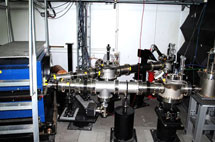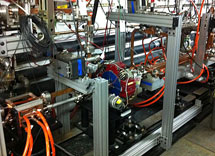
Handy Links
SLAC News Center
SLAC Today
- Subscribe
- Archives: Feb 2006-May 20, 2011
- Archives: May 23, 2011 and later
- Submit Feedback or Story Ideas
- About SLAC Today
SLAC News
Lab News
- Interactions
- Lightsources.org
- ILC NewsLine
- Int'l Science Grid This Week
- Fermilab Today
- Berkeley Lab News
- @brookhaven TODAY
- DOE Pulse
- CERN Courier
- DESY inForm
- US / LHC
SLAC Links
- Emergency
- Safety
- Policy Repository
- Site Entry Form

- Site Maps
- M & O Review
- Computing Status & Calendar
- SLAC Colloquium
- SLACspeak
- SLACspace
- SLAC Logo
- Café Menu
- Flea Market
- Web E-mail
- Marguerite Shuttle
- Discount Commuter Passes
-
Award Reporting Form
- SPIRES
- SciDoc
- Activity Groups
- Library
Stanford
Around the Bay
From Echo-7 to Echo-15: Upgrade Nears Completion
Members of the Echo-7 team are putting the finishing touches on a number of upgrades to the Next Linear Collider Test Accelerator in SLAC's End Station B. The upgrades will enable the team to delve more deeply into the physics behind last summer's successful demonstration of a phenomenon called echo-enabled harmonic generation. A second goal is to create radiation of even greater coherence, based on higher harmonics, or related wavelengths, than were reached during those initial trials.
Originally proposed by SLAC accelerator theorist Gennady Stupakov, EEHG shows promise as a method for generating X-ray laser pulses of even higher quality than those of the Linac Coherent Light Source. The LCSL pulses are spatially coherent but not temporally coherent—think of them as identical siblings running a race, all randomly scattered at different points along the straightaway. EEHG puts the runners at precise intervals. When translated back to X-ray lasers, the temporal coherence provided by EEHG is an important property for beams used in ultrahigh-precision microscopy and imaging studies.
During last summer's experiments, the Echo-7 team coaxed an electron beam to interact with a "seed" laser that caused the electrons in the beam to pack into bunches in just the right pattern to later generate temporally and spatially coherent light. In doing so they boosted the energy in the photon beam from the infrared range into the ultraviolet.
"This was the first demonstration of a potentially very important technique and now we need to study the effect in detail to understand how to use it in other accelerators," said Accelerator Research Division Director Tor Raubenheimer, the principal investigator for the experiment.
While the researchers saw clear evidence of temporal coherence in their results, they also saw evidence of high-gain harmonic generation, a different, less efficient way to generate temporally coherent beams. Both EEHG and HGHG rely on a process called "upconversion" of a wave—converting a particular wave into a higher harmonic of itself, so the wavelengths are precisely one-half the length of the original, or precisely one-third the length, or one-quarter, and so on. As the wavelengths shrink, the amount of energy carried by each wave grows. EEHG-generated waves reach higher harmonics with less effort than HGHG-generated waves—a good reason to focus on EEHG.
"We'd really like to confirm the [EEHG] model," said Carsten Hast, head of the Accelerator Test Facilities Department at SLAC. "We need to remove the HGHG component to do that."
One of the instruments installed during the upgrade will do just that. Called a transverse deflecting mode cavity, it will "heat" the beam to destroy the HGHG contribution, said Dao Xiang, the scientific lead on the experiment. Other improvements to the lasers used to manipulate the beam and the diagnostics used to examine it—such as a threefold improvement in the resolution of the beam spectrometer over the previous experiment—will enable the Echo-7 team to pinpoint EEHG effects and only EEHG effects.
In addition, the researchers intend to boost the effect so the EEHG-generated beam reaches the fifteenth harmonic of the initial beam, with each wave only one-fifteenth the length of the original. This would place the energy of the EEHG-generated beam in the extreme ultraviolet—one step down from X-rays. Hast doesn't think the NLCTA will ever generate X-rays for technical reasons, but it could come close.
"If we had a little more space and a little higher energy electron beam we could have another X-ray free electron laser," he joked.
—Lori Ann White
SLAC Today, April 19, 2011

